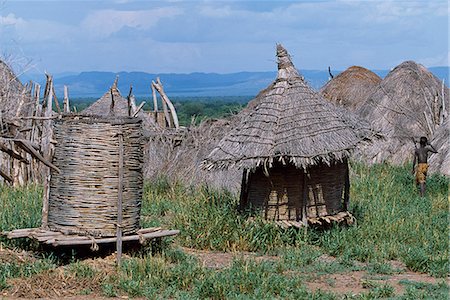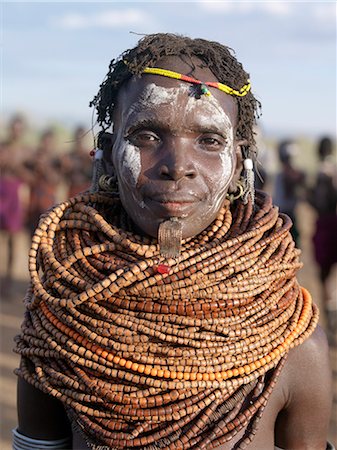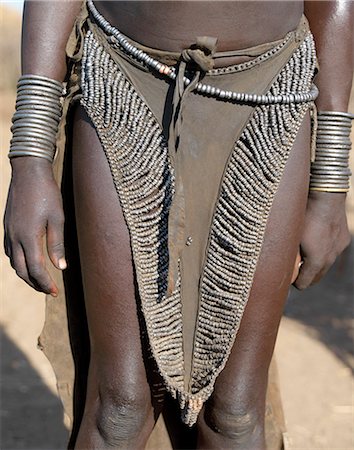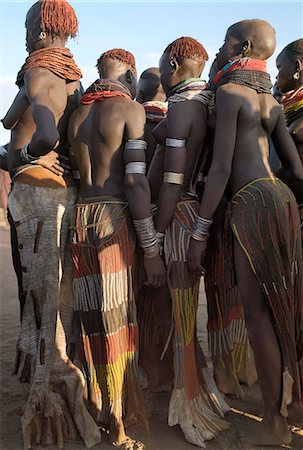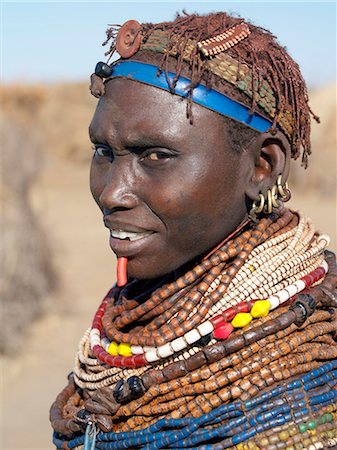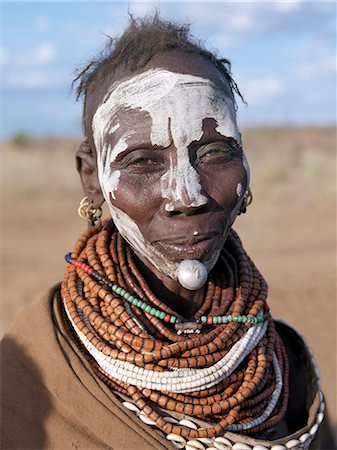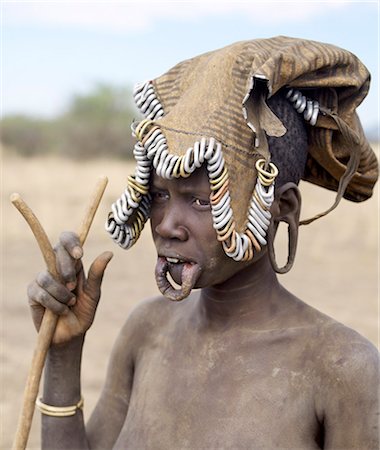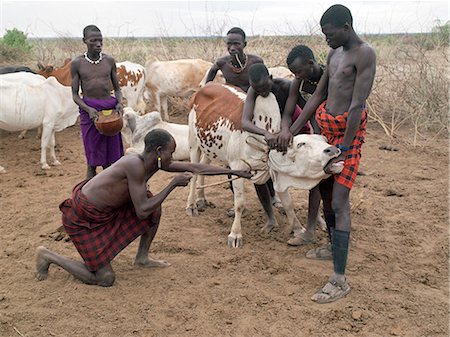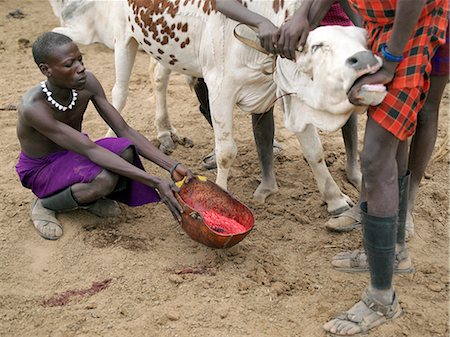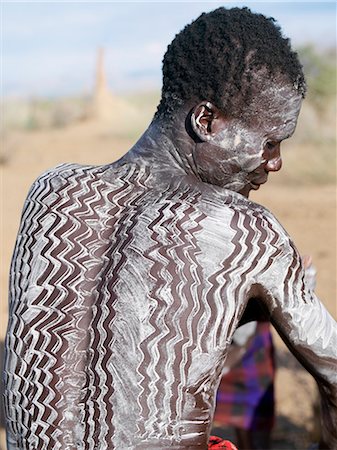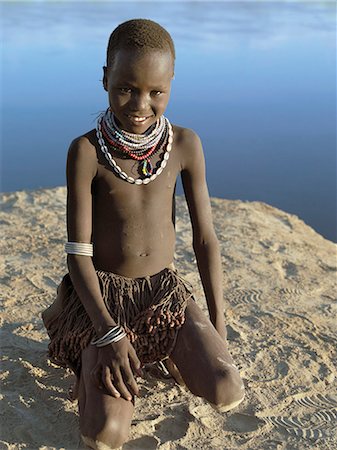-
A Dassanech woman carries a bundle of wood home at sunset. Much the largest of the tribes in the Omo Valley numbering around 50,000,the Dassanech (also known as the Galeb,Changila or Merille) are Nilotic pastoralists and agriculturalists.
Rights-Managed
-
A Dassanech elder wearing a traditional clay hairdo, topped with ostrich feathers. His broad beaded necklace is unusual for its size but his five brass earrings are a common decoration of both men and women.The Dassanech people live in the Omo Delta of southwest Ethiopia, one of the largest inland deltas in the world.
Rights-Managed
-
An elder of the Karo tribe,a small Omotic tribe related to the Hamar,who live along the banks of the Omo River in southwestern Ethiopia. The Karo are renowned for their elaborate body painting using white chalk,crushed rock and other natural pigments. This man also has a clay hairdo decorated with bustard feathers which is typical of tribal elders.
Rights-Managed
-
The men hold hands forming a circle within which the women dance in the Karo village of Duss. A small Omotic tribe related to the Hamar,the Karo live along the banks of the Omo River in southwestern Ethiopia. They are renowned for their elaborate body art using white chalk,crushed rock and other natural pigments.
Rights-Managed
-
A young girl of the Karo tribe has attached tassles of cowskin to her steel amulets. She wears a skirt of calfskin edged in metal beads. A small Omotic tribe related to the Hamar,who live along the banks of the Omo River in southwestern Ethiopia,the Karo are renowned for their elaborate body painting using white chalk,crushed rock and other natural pigments.
Rights-Managed
-
The grass huts and granary stores of a Nyangatom settlement. The Nyangatom or Bume are a Nilotic tribe of semi-nomadic pastoralists who live along the banks of the Omo River in south-western Ethiopia.
Rights-Managed
-
A Dassanech man ferries people and firewood in a large dug-out canoe across the crocodile-infested waters of the Omo River near its delta at the northern end of Lake Turkana. The Omo has one of the largest inland deltas in the world and is home to a large section of Dassanech people who speak a language of Eastern Cushitic origin.
Rights-Managed
-
A Mursi girl with scarification on the left side of her back. Shortly before she marries, her lower lip will be pierced and progressively stretched over a year or so to insert a clay lip plate. The size of the lip plate often determines the quantum of the bride price.
Rights-Managed
-
A Mursi woman wearing a large clay lip plate. Shortly before marriage, a girls lower lip will be pierced and progressively stretched over a year or so. The size of the lip plate often determines the quantum of the bride price. The reason for this singular practice is not fully understood but Mursi women will claim that it enhances their beauty.
Rights-Managed
-
A Dassanech man ferries people in a large dug-out canoe across the crocodile-infested waters of the Omo River near its delta at the northern end of Lake Turkana. The Omo has one of the largest inland deltas in the world and is home to a large section of Dassanech people who speak a language of Eastern Cushitic origin.
Rights-Managed
-
An old Dassanech woman prepares her fields beside the Omo River with a digging stick in readiness to plant sorghum. This crude form of agricultural implement is in common use in this remote part of Ethiopia.
Rights-Managed
-
Karo men excel in body art. They decorate their faces and torsos elaborately using local white chalk, pulverised rock and other natural pigments. Older men often wear clay hairdos but braided hairstyles are typical of the younger generation.
Rights-Managed
-
A Nyangatom girl with unusual body scarification.The Nyangatom are one of the largest tribes and arguably the most warlike people living along the Omo River in Southwest Ethiopia. They form a part of the Ateger speaking people a cluster of seven eastern Nilotic tribes to which the Turkana of Northern Kenya and the Karamajong of Eastern Uganda belong.
Rights-Managed
-
An elder of the Karo tribe rests with his head on his wooden head rest which protects his elaborate clay hairdo. Every man carries a headrest which doubles as a stool. This man has attached his snuff box to it. A small Omotic tribe related to the Hamar, who live along the banks of the Omo River in southwestern Ethiopia.
Rights-Managed
-
A Mursi woman stands with a clay pot on her head beside her hut in a village in the Omo Valley. Once married Mursi women pierce their lower lip and stretch it by inserting increasingly large plugs until they can wear a clay lip plate. This woman is not wearing her lip plate so her lower lip hangs loose. Within the Omo Valley, the Mursi have a reputation for being extremely fierce and aggressive. T
Rights-Managed
-
A Mursi woman with a clay lip plate. Once married, Mursi women pierce their lower lip and stretch it by inserting increasingly large plugs until they can wear a clay lip plate. The size of the lip plate reflects the bride price paid by their husband. Within the Omo Valley, the Mursi have a reputation for being extremely fierce and aggressive. They are also renowned for their skill at making clay
Rights-Managed
-
A braided hairstyle of a Dassanech young man of the Omo River Delta.His ears are pierced in five places round the rim.The Omo Delta of southwest Ethiopia is one of the least accessible and least developed parts of East Africa.As such, the culture, social organization, customs and values of the people have changed less than elsewhere.
Rights-Managed
-
A pregnant Nyangatom woman in traditional attire outside her neatly thatched home.The Nyangatom are one of the largest tribes and arguably the most warlike people living along the Omo River in Southwest Ethiopia.
Rights-Managed
-
A Dassanech man poles a dug-out canoe across the muddy waters of a tributary of the Omo River in its delta near Lake Turkana. The Omo has one of the largest inland deltas in the world and is home to a large section of Dassanech people who speak a language of Eastern Cushitic origin.
Rights-Managed
-
A young girl of the Karo tribe has attached tassles of cowskin to her steel amulets. She wears a skirt of calfskin edged in metal beads. A small Omotic tribe related to the Hamar,who live along the banks of the Omo River in southwestern Ethiopia,the Karo are renowned for their elaborate body painting using white chalk,crushed rock and other natural pigments.
Rights-Managed
-
A Dassanech girl leaning against a bale of cattle fodder on a raised platform is silhouetted against the evening sky at a settlement alongside the Omo River. Much the largest of the tribes in the Omo Valley numbering around 50,000,the Dassanech (also known as the Galeb,Changila or Merille) are Nilotic pastoralists and agriculturalists.
Rights-Managed
-
A Kwego woman grinds sorghum flour at the entrance to her hut. The Kwego are a Nilotic tribe of semi-nomadic pastoralists who live along the banks of the Omo River in south-western Ethiopia.
Rights-Managed
-
The detail of a Mursi womans decorated leather skirt.The Mursi speak a Nilotic language and have affinities with the Shilluk and Anuak of eastern Sudan.They live in a remote area of southwest Ethiopia along the Omo River, the countrys largest river
Rights-Managed
-
A massive Nile crocodile ready to kill in the Omo River. Although the Dassanech hunt crocodiles at night, they are here among the most dangerous reptiles to humans, Ethiopia
Rights-Managed
-
Karo men and girls enjoy a dance.The Karo excel in body art. Before dances and ceremonial occasions, they decorate themselves elaborately using local white chalk, pulverised rock and other natural pigments.The Karo are a small tribe living in three main villages along the lower reaches of the Omo River in southwest Ethiopia.
Rights-Managed
-
A young Karo girl has decorated herself with face paint,an intricate braided hairstyle and layers of beads. A small Omotic tribe related to the Hamar,who live along the banks of the Omo River in southwestern Ethiopia,the Karo are renowned for their elaborate body painting using white chalk,crushed rock and other natural pigments.
Rights-Managed
-
A Nyangatom woman wears numerous strands of beads made from wood.The Nyangatom are one of the largest tribes and arguably the most warlike people living along the Omo River in Southwest Ethiopia. They form a part of the Ateger speaking people a cluster of seven eastern Nilotic tribes to which the Turkana of Northern Kenya and the Karamajong of Eastern Uganda belong.
Rights-Managed
-
An elder of the Karo tribe,a small Omotic tribe related to the Hamar,who live along the banks of the Omo River in southwestern Ethiopia. The Karo are renowned for their elaborate body painting using white chalk,crushed rock and other natural pigments. This man also has a clay hairdo typical of tribal elders.
Rights-Managed
-
The leather skirt of a Nyangatom girl richly decorated with metal beads.The Nyangatom are one of the largest tribes and arguably the most warlike people living along the Omo River in Southwest Ethiopia.
Rights-Managed
-
A Karo woman paints her daughters face with white chalk. The mother has styled her hair with mud and ochre. She wears a calfskin cape edged with cowrie shells, and layers of beads, bracelets and amulets. A small Omotic tribe related to the Hamar, who live along the banks of the Omo River in southwestern Ethiopia.
Rights-Managed
-
A Mursi man sits with his wife. Once married, Mursi women pierce their lower lip and stretch it by inserting increasingly large plugs until they can wear a clay lip plate. The size of the lip plate reflects the bride price paid by their husband. Within the Omo Valley, the Mursi have a reputation for being extremely fierce and aggressive.
Rights-Managed
-
Karo villagers at a dance in the village of Duss. A small Omotic tribe related to the Hamar,the Karo live along the banks of the Omo River in southwestern Ethiopia. They are renowned for their elaborate body art using white chalk,crushed rock and other natural pigments.
Rights-Managed
-
Men dance by jumping up into the air while holding hands in the Karo village of Duss. A small Omotic tribe related to the Hamar,the Karo live along the banks of the Omo River in southwestern Ethiopia. They are renowned for their elaborate body art using white chalk,crushed rock and other natural pigments.
Rights-Managed
-
A group of Nyangatom girls and women with beautifully decorated leather skirts gather to dance.The Nyangatom are one of the largest tribes and arguably the most warlike people living along the Omo River in Southwest Ethiopia.
Rights-Managed
-
A finely decorated clay hairstyle of a Dassanech young man of the Omo River Delta. The rectangular decorations on top of the head are ostrich feather holders, which are made from the pounded sinews of oxen intertwined with thin brass wire.
Rights-Managed
-
A Karo mother carries her baby on her hip. She has decorated herself with face paint,a hairdo styled with mud and ochre and layers of beads and amulets. A small Omotic tribe related to the Hamar,who live along the banks of the Omo River in southwestern Ethiopia,the Karo are renowned for their elaborate body painting using white chalk,crushed rock and other natural pigments.
Rights-Managed
-
A Dassanech girl leaning against a bale of cattle fodder on a raised platform is silhouetted against the evening sky at a settlement alongside the Omo River. Much the largest of the tribes in the Omo Valley numbering around 50,000,the Dassanech (also known as the Galeb,Changila or Merille) are Nilotic pastoralists and agriculturalists.
Rights-Managed
-
The typical hairstyle of a young Mursi girl.The Mursi speak a Nilotic language and have affinities with the Shilluk and Anuak of eastern Sudan.They live in a remote area of southwest Ethiopia along the Omo River, the countrys largest river.
Rights-Managed
-
A group of Nyangatom girls and women with beautifully decorated leather skirts gather to dance.The Nyangatom are one of the largest tribes and arguably the most warlike people living along the Omo River in Southwest Ethiopia.
Rights-Managed
-
Karo men excel in body art. They decorate their faces and torsos elaborately using local white chalk, pulverised rock and other natural pigments. Braided hairstyles are typical of the young men.The Karo are a small tribe living in three main villages along the lower reaches of the Omo River in southwest Ethiopia.
Rights-Managed
-
The decorated leather skirt of a married Nyangatom woman. The skirt is made from cowhide.The Nyangatom are one of the largest tribes and arguably the most warlike people living along the Omo River in Southwest Ethiopia.
Rights-Managed
-
A Nyangatom boy catches blood from the artery of a cow in a gourd. The cow is bled by firing an arrow with a very short head into the artery of the cow. Several pints of blood will be collected which will then be mixed with milk and drunk by the Nyangatom. The Nyangatom or Bume are a Nilotic tribe of semi-nomadic pastoralists who live along the banks of the Omo River in south-western Ethiopia.
Rights-Managed
-
Dassanech children play on the bank of the Omo River at sunset. Much the largest of the tribes in the Omo Valley numbering around 50,000,the Dassanech (also known as the Galeb,Changila or Merille) are Nilotic pastoralists and agriculturalists.
Rights-Managed
-
A Karo woman shows off her attractive face paint,layers of necklaces and hairdo styled with mud and ochre. A small Omotic tribe related to the Hamar,who live along the banks of the Omo River in southwestern Ethiopia,the Karo are renowned for their elaborate body painting using white chalk,crushed rock and other natural pigments.
Rights-Managed
-
A Karo woman carries her baby on her hip at their temporary camp on the bank of the Karo River. Meat from a slaughtered animal hangs drying on a pole outside her hut. A small Omotic tribe related to the Hamar,who live along the banks of the Omo River in southwestern Ethiopia,the Karo are renowned for their elaborate body painting using white chalk,crushed rock and other natural pigments.
Rights-Managed
-
At a dance in the Karo village of Duss men stand waiting to dance. A small Omotic tribe related to the Hamar,the Karo live along the banks of the Omo River in southwestern Ethiopia. They are renowned for their elaborate body art using white chalk,crushed rock and other natural pigments.
Rights-Managed
-
Karo men excel in body art. They decorate their faces and torsos using local white chalk, pulverised rock and other natural pigments. Clay hairdos are common among older men but braided hairstyles are typical of the younger generation.Almost every man owns a gun usually an AK 47 assault rifle and keeps spare ammunition in a cartridge belt around his waist.
Rights-Managed
-
A Dassanech man shows off his distinctive clay hairdo. The central pannel consists of tightly packed coils of sisal thread extracted from grain sacks that allow the scalp to breathe underneath the clay. Much the largest of the tribes in the Omo Valley numbering around 50,000,the Dassanech (also known as the Galeb,Changila or Merille) are Nilotic pastoralists and agriculturalists.
Rights-Managed
-
An unusual braided hairstyle of a Dassanech young man of the Omo River Delta.The Omo Delta of southwest Ethiopia is one of the least accessible and least developed parts of East Africa.As such, the culture, social organization, customs and values of the people have changed less than elsewhere.
Rights-Managed
-
A Mursi woman wearing a large clay lip plate and ear ornaments to match.Shortly before marriage, a girls lower lip will be pierced and progressively stretched over a year or so while some of her teeth will be removed for the plate to fit snugly. The size of the lip plate often determines the quantum of the bride price. The reason for this singular practice is not fully understood but Mursi women
Rights-Managed
-
A Mursi woman with decorated face and body scarification wears a large clay lip plate. Shortly before marriage, a girls lower lip will be pierced and progressively stretched over a year or so while some of her teeth will be removed for the plate to fit snugly.The size of the lip plate often determines the quantum of the bride price.The reason for this singular practice is not fully understood but
Rights-Managed
-
A Mursi woman wearing a large clay lip plate and ear ornaments to match.Shortly before marriage, a girls lower lip will be pierced and progressively stretched over a year or so while some of her teeth will be removed for the plate to fit snugly.The size of the lip plate often determines the quantum of the bride price. The reason for this singular practice is not fully understood but Mursi women
Rights-Managed
-
A Mursi woman wearing a large clay lip plate and ear ornaments to match.Shortly before marriage, a girls lower lip will be pierced and progressively stretched over a year or so while some of her teeth will be removed for the plate to fit snugly.The size of the lip plate often determines the quantum of the bride price. The reason for this singular practice is not fully understood but Mursi women
Rights-Managed
-
A Mursi woman wearing a large clay lip plate and ear ornaments to match.Shortly before marriage, a girls lower lip will be pierced and progressively stretched over a year or so while some of her teeth will be removed for the plate to fit snugly.The size of the lip plate often determines the quantum of the bride price. The reason for this singular practice is not fully understood but Mursi women
Rights-Managed
-
The Karo excel in body art. Before dances and ceremonial occasions, they decorate their faces and torsos elaborately using local white chalk, pulverised rock and other natural pigments. Young men like their hair braided in striking styles.The Karo are a small tribe living in three main villages along the lower reaches of the Omo River in southwest Ethiopia.
Rights-Managed
-
The Karo excel in body art. Before dances and ceremonial occasions, they decorate their faces and torsos elaborately using local white chalk, pulverised rock and other natural pigments. Young men like their hair braided in striking styles.The Karo are a small tribe living in three main villages along the lower reaches of the Omo River in southwest Ethiopia.
Rights-Managed
-
In the late afternoon, Nyangatom villagers enjoy singing and dancing. As groups of men take centre stage to jump high in the air, women and girls sing, clap to a rhythm, and move slowly towards the men. Children enjoy the excitement in the background.The Nyangatom are one of the largest tribes and arguably the most warlike people living along the Omo River in Southwest Ethiopia.
Rights-Managed
-
In the late afternoon, Nyangatom villagers enjoy singing and dancing. As groups of men take centre stage to jump high in the air, women and girls sing, clap to a rhythm, and move slowly towards the men. Children enjoy the excitement in the background.The Nyangatom are one of the largest tribes and arguably the most warlike people living along the Omo River in Southwest Ethiopia.
Rights-Managed
-
The framework of a Karo house under construction close to the Omo River. The small thatched huts built off the ground are food stores.The Karo are a small tribe living in three main villages along the lower reaches of the Omo River in southwest Ethiopia.
Rights-Managed
-
A Karo homestead close the Omo River. The small thatched huts built off the ground are food stores.The Karo are a small tribe living in three main villages along the lower reaches of the Omo River in southwest Ethiopia.
Rights-Managed
-
A Nyangatom woman wears numerous strands of beads made from wood.The Nyangatom are one of the largest tribes and arguably the most warlike people living along the Omo River in Southwest Ethiopia. They form a part of the Ateger speaking people a cluster of seven eastern Nilotic tribes to which the Turkana of Northern Kenya and the Karamajong of Eastern Uganda belong.
Rights-Managed
-
A Nyangatom woman wears numerous strands of beads made from wood.The Nyangatom are one of the largest tribes and arguably the most warlike people living along the Omo River in Southwest Ethiopia. They form a part of the Ateger speaking people a cluster of seven eastern Nilotic tribes to which the Turkana of Northern Kenya and the Karamajong of Eastern Uganda belong.
Rights-Managed
-
A Mursi girl dressed in finely decorated leather garments with a beautifully made basket over one shoulder. Her partially shaven head is the typical hairstyle of her tribe.The Mursi speak a Nilotic language and have affinities with the Shilluk and Anuak of eastern Sudan. They live in a remote area of southwest Ethiopia along the Omo River, the country's largest river.
Rights-Managed
-
The Karo excel in body art. Before dances and ceremonial occasions, they decorate their faces and torsos elaborately using local white chalk, pulverised rock and other natural pigments. Young men like their hair braided in striking styles.The Karo are a small tribe living in three main villages along the lower reaches of the Omo River in southwest Ethiopia.
Rights-Managed
-
Young Dassanech boys run along a bank of the Omo River in Southwest Ethiopia.The Dassanech speak a language of Eastern Cushitic origin.They live in the Omo Delta and they practice animal husbandry and fishing as well as agriculture.
Rights-Managed
-
An old Kwegu man with a lip ornament made of aluminium.The Kwegu known to the Karo as Muguji, a degoratory name meaning Working Ant, are the smallest tribe living on the banks the Omo River in southwest Ethiopia.
Rights-Managed
-
A Mursi man with scarification in the shape of a crown.The Mursi speak a Nilotic language and have affinities with the Shilluk and Anuak of eastern Sudan. They live in a remote area of southwest Ethiopia along the Omo River.
Rights-Managed
-
A Nyangatom woman wears numerous strands of beads made from wood.The Nyangatom are one of the largest tribes and arguably the most warlike people living along the Omo River in Southwest Ethiopia. They form a part of the Ateger speaking people a cluster of seven eastern Nilotic tribes to which the Turkana of Northern Kenya and the Karamajong of Eastern Uganda belong.
Rights-Managed
-
An armed Mursi man wearing a heavy ivory bracelet round his left wrist.The Mursi speak a Nilotic language and have affinities with the Shilluk and Anuak of eastern Sudan. They live in a remote area of southwest Ethiopia along the Omo River.
Rights-Managed
-
A Mursi woman wearing a large clay lip plate and ear ornaments to match.Shortly before marriage, a girls lower lip will be pierced and progressively stretched over a year or so while some of her teeth will be removed for the plate to fit snugly. The size of the lip plate often determines the quantum of the bride price. The reason for this singular practice is not fully understood but Mursi women
Rights-Managed
-
Silhouette of an armed Nyangatom herdsman on the banks of the Omo River. Almost every male member of the tribe owns a rifle, the majority of which are AK47 assault rifles.The Nyangatom are one of the largest tribes and arguably the most warlike people living along the Omo River in Southwest Ethiopia.
Rights-Managed
-
A group of Nyangatom men draw blood from a steer early in the morning. A leather tourniquet is tied round the animals neck before the jugular pierced with a short, sharp arrow.Two or three pints will be drawn from a healthy steer, which will not be bled again for a month.The Nyangatom are one of the largest tribes and arguably the most warlike people living along the Omo River in Southwest Ethiopi
Rights-Managed
-
A group of Nyangatom men draw blood from a steer early in the morning. A leather tourniquet is tied round the animals neck before the jugular pierced with a short, sharp arrow.Two or three pints will be drawn from a healthy steer, which will not be bled again for a month.The Nyangatom are one of the largest tribes and arguably the most warlike people living along the Omo River in Southwest Ethiopi
Rights-Managed
-
A Karo homestead close the Omo River. The small thatched huts built off the ground are food stores.The Karo are a small tribe living in three main villages along the lower reaches of the Omo River in southwest Ethiopia.
Rights-Managed
-
The Karo excel in body art. Before dances and ceremonial occasions, they decorate their faces and torsos elaborately using local white chalk, pulverised rock and other natural pigments. Young men like their hair braided in striking styles.The Karo are a small tribe living in three main villages along the lower reaches of the Omo River in southwest Ethiopia.
Rights-Managed
-
Nyangatom men decorate themselves with white chalk, pulverised rock or other natural pigments before a dance.The Nyangatom are one of the largest tribes and arguably the most warlike people living along the Omo River in Southwest Ethiopia.
Rights-Managed
-
The typical hairstyle of a young Mursi girl.The Mursi speak a Nilotic language and have affinities with the Shilluk and Anuak of eastern Sudan.They live in a remote area of southwest Ethiopia along the Omo River, the countrys largest river.
Rights-Managed
-
A Mursi child is carried safely in her mothers decorated leather garments.The Mursi speak a Nilotic language and have affinities with the Shilluk and Anuak of eastern Sudan.They live in a remote area of southwest Ethiopia along the Omo River.
Rights-Managed
-
Karo men and girls enjoy a dance.The Karo excel in body art. Before dances and ceremonial occasions, they decorate themselves elaborately using local white chalk, pulverised rock and other natural pigments.The Karo are a small tribe living in three main villages along the lower reaches of the Omo River in southwest Ethiopia.
Rights-Managed
-
A Nyangatom woman wears numerous strands of beads made from wood.The Nyangatom are one of the largest tribes and arguably the most warlike people living along the Omo River in Southwest Ethiopia. They form a part of the Ateger speaking people a cluster of seven eastern Nilotic tribes to which the Turkana of Northern Kenya and the Karamajong of Eastern Uganda belong.
Rights-Managed
-
A Kwegu man with his torso decorated with local white chalk.Almost every man owns a gun, usually an AK 47 assault rifle, and keeps spare ammunition in a cartridge belt around his waist.The Kwegu known to the Karo as Muguji, a degoratory name meaning Working Ant, are the smallest tribe living on the banks the Omo River in southwest Ethiopia.
Rights-Managed
-
At the start of a dance, Karo men sing and clap in line.The Karo excel in body art. Before dances and ceremonial occasions, they decorate themselves elaborately using local white chalk, pulverised rock and other natural pigments.The Karo are a small tribe living in three main villages along the lower reaches of the Omo River in southwest Ethiopia.
Rights-Managed
-
Nyangatom cattle are driven through arid, dusty country to water on the Omo River.The Nyangatom are one of the largest tribes and arguably the most warlike people living along the Omo River in Southwest Ethiopia.
Rights-Managed
-
A Karo man poles a dugout canoe across the Omo River. The Karo are a small tribe living in three main villages along the lower reaches of the Omo River in southwest Ethiopia.
Rights-Managed
-
A young Nyangatom girl on the banks of the Omo River.The Nyangatom are one of the largest tribes and arguably the most warlike people living along the Omo River in Southwest Ethiopia. They form a part of the Ateger speaking people a cluster of seven eastern Nilotic tribes to which the Turkana of Northern Kenya and the Karamajong of Eastern Uganda belong.
Rights-Managed
-
A Kwegu mother and her children outside their family home. The Kwegu known to the Karo as Muguji, a degoratory name meaning Working Ant, are the smallest tribe living on the banks the Omo River in southwest Ethiopia.
Rights-Managed
-
A young Kwegu girl garlanded with wild Desert Rose flowers.Adopting the practice of Karo women and girls, many Kwegu girls pierce a hole below the lower lip in which they place a thin piece of metal or a nail for decoration.The Kwegu known to the Karo as Muguji, a degoratory name meaning Working Ant, are the smallest tribe living on the banks the Omo River in southwest Ethiopia.
Rights-Managed
-
The Karo excel in body art. Before dances and ceremonial occasions, they decorate their faces and torsos elaborately using local white chalk, pulverised rock and other natural pigments. Young men like their hair braided in striking styles.The Karo are a small tribe living in three main villages along the lower reaches of the Omo River in southwest Ethiopia.
Rights-Managed
-
A Nyangatom woman milks her familys cows early in the morning. It is the sole responsibility of women and children to milk cows, Nyangatom men will never do so.The Nyangatom are one of the largest tribes and arguably the most warlike people living along the Omo River in Southwest Ethiopia.
Rights-Managed





